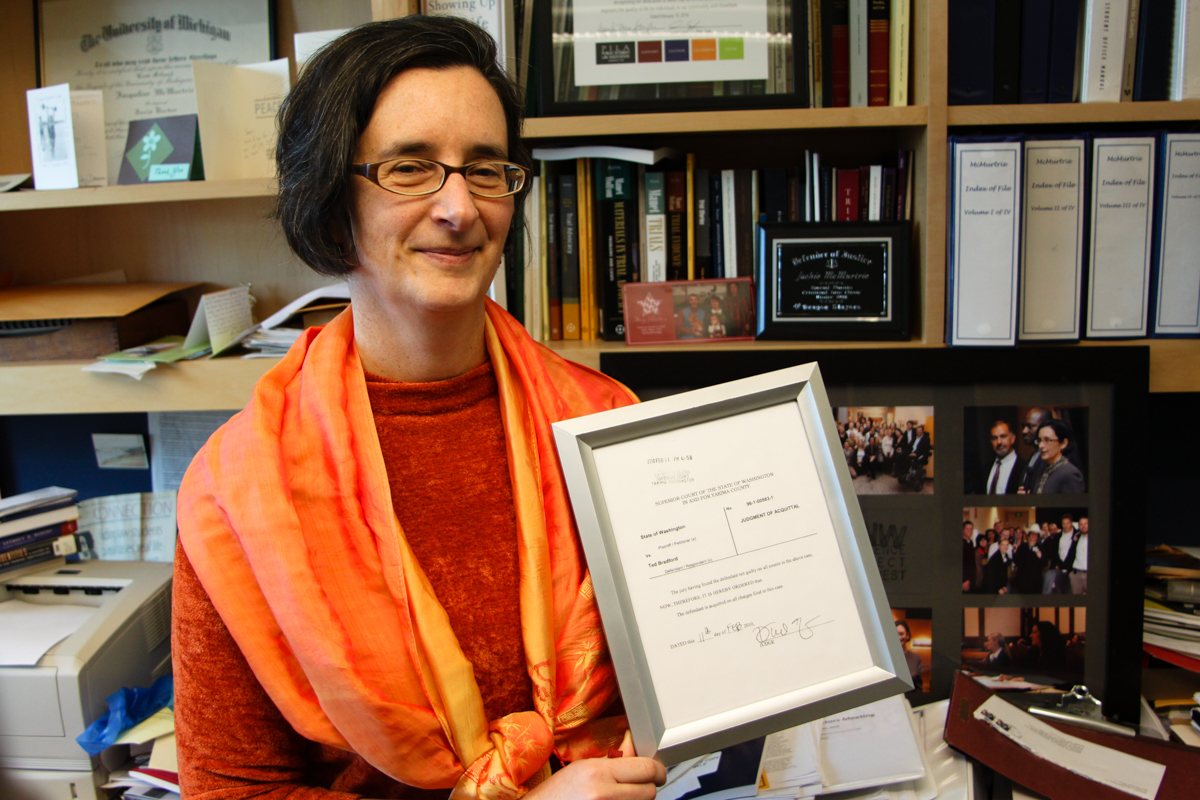Innocence Project Northwest

On a rare sunny day in downtown Seattle, the conference room of suite 265 was exceptionally bright as I sat down with Jackie McMurtrie, Professor of Law and head of the Innocence Project Northwest (IPNW). McMurtrie joined the staff at the University of Washington in 1989 as a supervisor in the misdemeanor Criminal Law clinic supervising third year law students. By 1996, McMurtrie had heard about the work of the Innocence Project in New York, but it was a Frontline documentary entitled “What Jennifer Saw,” that provided the spark that changed the direction of her career. “What Jennifer Saw” tells the story of Ronald Cotton, a North Carolina man who was wrongfully convicted of two rapes in 1984 as a result of what turned out to be a false eyewitness account. After a flurry of appeals, he was exonerated by DNA evidence after 10 years in prison. The documentary disturbed and inspired McMurtrie, and she decided, “We need an Innocence Project in Seattle, and so in 1997 I founded the Innocence Project here at the law school.”
The IPNW became the third innocence project in the country. Chartered by McMurtrie and defense attorney Fred Leatherman, the project was initially a volunteer organization. “Everybody, myself included, was volunteering their time to the effort. It started very slowly because I didn’t have a strategic plan or any kind of funding,” McMurtrie said.
They began to receive letters from inmates, explaining the details of their cases and pleading for help. In 1998, IPNW sprung into action with their first major effort in response to a series of events that took place in Wenatchee, Washington in 1995. According to prosecutors, Wenatchee was home to a massive child abuse sex ring. Based initially on the allegations of Detective Robert Perez’s foster daughter, 43 people were charged with 29,726 counts of child sex abuse. The convictions were doled out expeditiously despite the absence of any physical evidence. It soon became clear that the justice system had not been effective in the Wenatchee cases, and the events began to garner national attention.
“We got involved in coordinating the representation of people who were still in prison on those charges, there were about 13 people that were still imprisoned, and set up teams of lawyers and law students to work on the cases. That was about a three year effort and at end, 11 of the clients were released from prison,” McMurtrie explained. McMurtrie did not have any clients of her own at the time and acted as coordinator for the teams assembled by IPNW.
By the time that these cases came to conclusion around 2000, McMurtrie had made up her mind. She began to take the necessary steps to make her work on the project her main professional focus. “I asked for permission from the law school for the Innocence Project to be my teaching responsibility, and in 2002 I started teaching the Innocence Project Northwest clinic, working with second and third year law students on cases of people who said they were imprisoned for crimes they did not commit,” McMurtrie said.
The primary difference between the early IPNW and the IPNW clinic is the involvement of students. “Their involvement provides the students with an educational opportunity. It’s not just the casework, it’s also coursework. We study the legal framework for bringing these claims, and we also study the causes of wrongful convictions,” McMurtrie said.

For some students like Elizabeth Sher the possibility of working for the IPNW clinic is a major incentive to enroll at the University of Washington Law School. Elizabeth Sher is a second year law student who joined the clinic beginning this fall. “It’s great to be able to have clients and actually play such a critical role in the cases as a student. We do all the work on [the cases]. It’s exciting to have that much responsibility and to go through the steps,” Sher said.
Amanda Mobrand is also a second year law student at the University of Washington. Mobrand also enrolled in the clinic this fall and was inspired by the IPNW to pursue a career in law. “It was actually reading about the Innocence Project in one of my Law, Society and Justice classes that got me interested in law school in the first place. We have a lot of responsibility, we get to have our own case and now actually I have two, and that’s pretty cool. In law school this is the only chance we have to actually work on cases,” Mobrand said.
As the name of the clinic would suggest, McMurtrie initially planned to represent clients throughout the Northwest region, but quickly realized there was simply not enough time or staff to do so. “That was not possible. We only take cases in Washington state of people who say they didn’t commit the crime, who no longer have the right to court appointed counsel and are indigent,” McMurtrie said.
The IPNW takes cases that pertain to DNA evidence, in addition to other cases that demonstrate a possible digression from justice. The clinic receives between 30-50 letters per month from inmates, most of whom are incarcerated in other states. Cases are initially screened by volunteers and paralegals to determine whether the cases fit the clinic’s criteria before moving forward in the process. The clinic is highly selective and each year between 15 and 20 cases that have been examined in depth are still rejected. Currently IPNW has 25 open cases at various stages of litigation, in addition to approximately 120 cases that have been accepted but have yet to be opened. For the requests from other states IPNW representatives refer the prisoners to other chapters around the nation.
Each year the clinic admits 13 law students after they are vetted through an application process. Students receive class credit for their work in addition to real world skills training through their work on individual cases. Second year students entering the clinic are eligible to continue their studies into their third year as members of the advanced clinic.
While the duration of each case varies greatly, on average cases take years to resolve. As a result, there is a constant turnover in the student representation at the clinic. “It was extremely difficult when I was the only person providing continuity,” McMurtrie said. Recently a previous student, Kelly Canary, has become a staff attorney for the clinic. “I can’t tell you how much that’s meant. Kelly provides that continuity in the cases and she’s able to take on, cases that wouldn’t be appropriate to assign to students,” McMurtrie said.
Serendipitously, the economic downturn has worked in IPNW’s favor. Last year the clinic received the assistance of John Pantasiz, a furloughed attorney that was provided with a stipend from his firm to work for a non-profit in the public interest. “He spent the year working on cases, and that’s really what made the cases move forward. It took one person working full time to take them to their completion,” McMurtrie said.
The IPNW has had many success stories including the recent acquittal of Ted Bradford, after he spent fifteen years in prison for a rape he did not commit, but it has its share of failure. Things have not always been so bright. A number of cases taken by the clinic have not exonerated the clients. “I wonder what it is to give clients hope that there might be a change and then have that hope dashed versus not giving them hope at all,” McMurtrie said.
“We just seem to be winning cases lately,” McMurtrie said.
“The Innocence Project is important because of the things we push, to make the system more accurate and just. If we could do all the things we wanted to we would put ourselves out of business, there wouldn’t be a need for an Innocence Project,” McMurtrie said.

Since 1992, 61 chapters of the Innocence Project have been created all over the country, and all states possess an incarnation of the program. To date the Innocence Projects nationwide have freed 261 individuals who served an average of 13 years before being exonerated.
Even though the rise of DNA evidence has allowed for the Innocence Project to successfully exonerate the wrongfully convicted, the increasing availability of DNA evidence for primary trials (which provides some protection against wrongful conviction) does not preclude the IPNW from a perennial future. “I think there will still be a need for an Innocence Project in 15-20 years if we don’t address some of the factors that we know cause wrongful convictions. There’s not going to DNA in every case that involves eyewitness testimony. We have to endeavor to make improvements in the way that cases are investigated in order to ensure that the system is accurate. DNA is not a panacea,” McMurtrie said.






